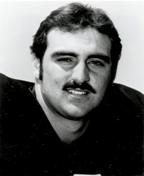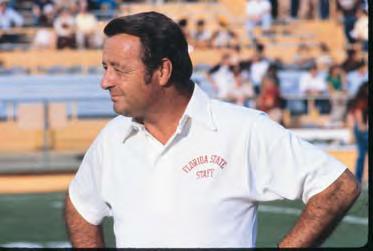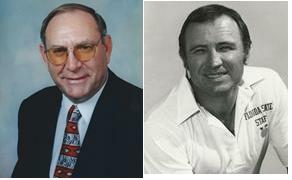A Good Story About A Bad Game
By Charlie Barnes, Guest Columnist
No, it wasn't my favorite Seminole game, but it is my favorite story about a game. It was the weekend of my birthday, mid-September of 1983. I had the pleasure of flying with the team to New Orleans to play the Tulane Green Wave.
 |
Kelly Lowrey |
The Seminoles were ranked No. 7 in the pre-season poll. We beat unranked East Carolina 47-46 in the season opener, and then outlasted No. 12 LSU 40-35 in Baton Rouge. Our offense behind quarterback Kelly Lowrey was phenomenal but defense was not the strength of the team.
Still, we were ranked in the Top 10 when we left for New Orleans. And Tulane was a dreadful team - The Green Wave would be a tune-up for us before we played the big game against Auburn.
Another plane landed at New Orleans' old Moisant International Airport about two hours before we arrived. This plane was carrying the University of Central Florida Knights, there to play the Southeast Louisiana Lions in Hammond, Louisiana. It was a game they would lose 54-28 on Saturday, but on that beautiful September Friday luck was with them.
Former Florida State Head Coach Bill Peterson was now the Athletics Director at UCF. After stepping off the plane, he was approached by a crisply outfitted Louisiana state trooper.
"Are you the football team from Florida?" the trooper asked.
Peterson saw the gleaming police cars with the flashing lights and the row of air-conditioned busses, and he smiled.
"Why ... yes," Peterson said. "Yes, we are the football team from Florida."
And so when we Seminoles arrived two hours later, that part of the runway was largely abandoned, the wind whistling across the empty tarmac ...
Somehow, the football staff managed to commandeer a string of school busses and we seemed finally to be on our way. But a tractor trailer jackknifed on one of the bridges into town causing another hours-long delay.
When we finally at the Marriott Hotel on Canal Street, the lobby was crowded with uniformed management types trying to sort through the growling hordes of guests who could neither check out nor check in because the hotel's computer had crashed.
Seminole players remained largely unsupervised in the lobby chaos and so, like a vapor, they began to slowly disappear from the hotel and make their way toward the delights of Bourbon Street two blocks away. They returned later in the evening, piecemeal, with broad smiles and happy hearts to be met by their coaches, who had neither.
On gameday we arrived at the Superdome.
Tulane was coached by Wally English, whose tenure at Tulane was brief and unhappy. In this game, however, the Green Wave was led by a gifted quarterback named Jon English, son of Wally.
Jon English was engaged in a lawsuit against Tulane and the NCAA alleging that he was being deprived of another season of eligibility. The day before Tulane's season opener, Jon's lawyers had won a restraining order that required the Green Wave to allow Jon English to play.
English had the most remarkable resume. He started out playing quarterback for the Michigan State Spartans, after which he transferred to Alleghany College where he also played quarterback. He then transferred to Iowa State, where he quarterbacked the Cyclones for a year and a half. Following that he transferred to Delgado Junior College in New Orleans, where we're told he tried his hand at baseball. All of this took place before finally arriving at nearby Tulane to play quarterback for his father.
By this time Jon English must have been close to 40 years old and was, in effect, the George Blanda of college football. His lawyers' theory that he should be allowed to play college ball until he was eligible for Social Security eventually ran aground, and the case was thrown out.
Under court order, Tulane played English in six games before he was declared ineligible. The Green Wave ended the year with a 2-9 record. English signed as a free agent with the New York Jets, who then placed him on waivers.
One of the compensating features of the Superdome, and certainly a welcome virtue on this day, is that fans are provided a full bar every 20 to 30 feet. I was working my way around the concourse and ended up sitting in the endzone next to a shabby fellow who was wearing a greasy Tulane Green Wave hat.
While we both nursed our cocktails, he said, "Your ends and linebackers are not getting to Jon English - would you like to know why?"
I was in a foul mood, so I didn't say what I really thought. Instead I said, "Yes, please."
It turned out this guy was the father of a Tulane player and he actually did know why our ends couldn't get to Jon English.
Coach Wally English had sent spies to FSU games with stopwatches to find out exactly how long it took FSU defenders to get to any quarterback. He and his staff then designed offensive plays to trigger just a half-second before our rushers arrived.
I didn't like the way that sounded. Tulane was supposed to roll over and play dead. The game was not going well for us, and it was going to get worse.
Even though he was slowed by a case of flu, with three seconds left in the half FSU took the lead on a Kelly Lowrey touchdown run and the worst was behind us. So you would think.
As the Seminoles piled into their locker-room at halftime they discovered that thieves had broken in and stolen players' and coaches' wallets and cash, plus a $6,000 gold and ruby FSU ring that had been a gift to Coach Bowden.
We lost that game 34-28. One week later, the courts threw Jon English and his theory of the eternal quarterback into the street and eventually the NCAA made Tulane forfeit the game to FSU.
But the damage was done. Our spirit and confidence were bruised. We had entered that game ranked No. 9 and dropped to No. 17 before our visit to 10th ranked Auburn. The Auburn loss was close, 24-27, but we never regained a national ranking that year. We lost a close game game at the end of the season to eventual 1983 National Champion Miami, followed by a blowout loss at Florida.
 |
Coach Bowden |
But there was good news, too. We had a winning season and beat North Carolina in the Peach Bowl. And after evaluating the direction of his program, Coach Bowden made some difficult decisions. Two of those decisions had profound influence on Florida State's journey toward the threshold of The Dynasty in 1987.
 |
Coaches Mickey Andrews & Gene McDowell |
First, Coach Bowden replaced several assistants and hired Mickey Andrews to run the defense. Andrews became the nation's premier defensive coordinator and would remain at FSU for the next 26 seasons.
Second, he put linebackers Coach Gene McDowell in charge of developing a professional recruiting program. Both Miami and Florida already had professional recruiting coordinators in place for several years.
McDowell's and Coach Brad Scott's new recruiting structure yielded the breathtaking 1985 class, packed with future Seminole greats and NFL standouts. It was easily the most talented class in Seminole history to that point.
The 29-man class included quarterbacks Chip Ferguson and P.T. Willis, defenders Odell Haggins and Eric Hayes, running back Sammie Smith and cornerback Deion Sanders and many more stars.
That stolen $6,000 gold-and-ruby FSU ring had been a gift from Palatka attorney and longtime Seminole supporter Ronnie Clark. In the spring of 1985 the Bobby Bowden Tour found its way back to Palatka where Coach Bowden was once again presented with a generous and unique gift from Clark.
This time, Clark had commissioned the making of an extraordinary Bowie knife that was both beautiful and frightening. It had an antler handle, and the blade had been strengthened by folding the steel hundreds of times.
Coach Bowden held the huge, gleaming blade up for everyone to see. "We're going back to New Orleans to play Tulane again this fall," he said. "And after the game ... I'm going to take this knife, and we're going looking for that ring!"
Charlie Barnes is the former vice president and executive director of Seminole Boosters.